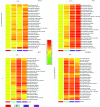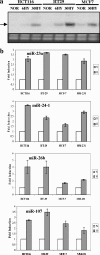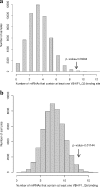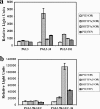A microRNA signature of hypoxia
- PMID: 17194750
- PMCID: PMC1820461
- DOI: 10.1128/MCB.01395-06
A microRNA signature of hypoxia
Abstract
Recent research has identified critical roles for microRNAs in a large number of cellular processes, including tumorigenic transformation. While significant progress has been made towards understanding the mechanisms of gene regulation by microRNAs, much less is known about factors affecting the expression of these noncoding transcripts. Here, we demonstrate for the first time a functional link between hypoxia, a well-documented tumor microenvironment factor, and microRNA expression. Microarray-based expression profiles revealed that a specific spectrum of microRNAs (including miR-23, -24, -26, -27, -103, -107, -181, -210, and -213) is induced in response to low oxygen, at least some via a hypoxia-inducible-factor-dependent mechanism. Select members of this group (miR-26, -107, and -210) decrease proapoptotic signaling in a hypoxic environment, suggesting an impact of these transcripts on tumor formation. Interestingly, the vast majority of hypoxia-induced microRNAs are also overexpressed in a variety of human tumors.
Figures







References
-
- Bartel, D. P. 2004. MicroRNAs: genomics, biogenesis, mechanism, and function. Cell 116:281-297. - PubMed
-
- Calin, G. A., M. Ferracin, A. Cimmino, G. Di Leva, M. Shimizu, S. E. Wojcik, M. V. Iorio, R. Visone, N. I. Sever, M. Fabbri, R. Iuliano, T. Palumbo, F. Pichiorri, C. Roldo, R. Garzon, C. Sevignani, L. Rassenti, H. Alder, S. Volinia, C. G. Liu, T. J. Kipps, M. Negrini, and C. M. Croce. 2005. A microRNA signature associated with prognosis and progression in chronic lymphocytic leukemia. N. Engl. J. Med. 353:1793-1801. - PubMed
-
- Calin, G. A., C. G. Liu, C. Sevignani, M. Ferracin, N. Felli, C. D. Dumitru, M. Shimizu, A. Cimmino, S. Zupo, M. Dono, M. L. Dell'Aquila, H. Alder, L. Rassenti, T. J. Kipps, F. Bullrich, M. Negrini, and C. M. Croce. 2004. MicroRNA profiling reveals distinct signatures in B cell chronic lymphocytic leukemias. Proc. Natl. Acad. Sci. USA 101:11755-11760. - PMC - PubMed
-
- Croce, C. M., and G. A. Calin. 2005. miRNAs, cancer, and stem cell division. Cell 122:6-7. - PubMed
Publication types
MeSH terms
Substances
Grants and funding
LinkOut - more resources
Full Text Sources
Other Literature Sources
